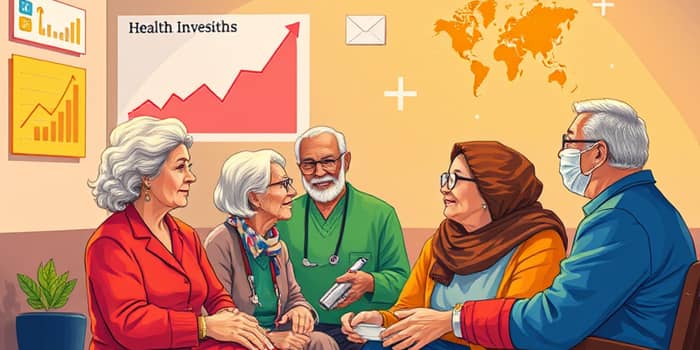
The world stands at a crossroads where longevity meets fiscal sustainability. As populations age, nations grapple with service demands, budgets, and equity challenges.
This article explores how demographic transitions are reshaping global health spending patterns and what governments, healthcare providers, and communities can do to navigate the coming years with resilience and compassion.
For the first time in human history, the number of people aged 65 and over is outpacing the growth of younger cohorts. This demographic phenomenon is driven by a significant demographic shift due to declining birth rates and remarkable gains in life expectancy.
Japan leads the world with over 29% of its citizens over 65, while Europe and North America follow closely behind. These shifts have profound social, economic, and healthcare implications, including the need for specialized geriatric care and long-term support services.
Communities must adapt to ensure that older adults remain active contributors to society, balancing independence and support through innovative programs and inclusive policies.
Health expenditure is climbing at an unprecedented pace. In 2023, the United States allocated 17.6% of its GDP to healthcare, a stark contrast to the global average of 3.8%. Other developed economies are also witnessing substantial increases.
The surge reflects higher demand for medical services and an aging populace requiring continuous care. In emerging markets, governments are challenged to expand coverage while maintaining fiscal stability.
Policymakers must balance short-term needs with long-term fiscal health, exploring cost-sharing, public-private partnerships, and targeted subsidies to keep systems afloat.
According to the WTW Global Medical Trends Survey, medical costs are set to climb by an average of 10.4% worldwide in 2025. These projections underscore an inflationary pressures and prescription drug spending environment that demands innovative solutions.
Rising costs are not uniform; they vary by region, driven by local policies, resource availability, and demographic profiles. Understanding these nuances is key to tailoring interventions that curb excess without sacrificing quality.
By closely monitoring these trends, stakeholders can anticipate budget pressures and invest in preventive measures, digital health tools, and community-based care models.
Despite overall spending increases, stark disparities persist. Low- and lower-middle-income countries often lack resources to meet basic healthcare demands. In many regions, public health expenditure falls below the global average, leaving vulnerable groups without adequate support.
Inequities manifest in access to medicines, availability of trained staff, and quality of infrastructure. When funding falls short, communities face higher mortality rates and preventable diseases become harder to control.
Global collaboration, innovative financing mechanisms, and capacity building are essential to narrowing these gaps and ensuring everyone receives dignified care.
The path ahead is fraught with challenges. The global health workforce shortage threatens service delivery, especially in rural and underserved areas. An increased dependency ratio among retirees strains public budgets as fewer workers support more beneficiaries.
Chronic diseases such as diabetes, heart disease, and dementia become more prevalent with age, requiring long-term management strategies. Without robust support systems, patients may face fragmented care and diminished quality of life.
However, there is reason for optimism. Through accelerated digital transformation in health, telemedicine, remote monitoring, and AI-driven diagnostics can enhance efficiency and patient engagement. Digital literacy programs and infrastructure investments will be pivotal to realizing these benefits across all regions.
Policymakers, healthcare organizations, and communities must unite to forge resilient systems. Drawing on insights from AMA policy research and PwC Health Research Institute, stakeholders can mobilize resources, incentivize preventive care, and optimize spending.
Collaborative initiatives such as regional health pools, cross-border research partnerships, and shared technology platforms can amplify impact and spread successful models.
Our collective future depends on how we respond to the twin challenges of aging and rising health costs. There is a positive correlation between spending and life expectancy, but without strategic reforms, gains may falter and inequalities may deepen.
Communities, governments, and individuals all have roles to play. Volunteers can support local care networks, philanthropists can fund breakthrough research, and citizens can advocate for policy changes that place people over profits.
We hold a collective responsibility for global well-being. Through innovation, solidarity, and wise investment, we can ensure that longer lives are celebrated and supported, not feared and burdened. By embracing collaboration, creativity, and compassion, humanity can turn a looming crisis into an era of lasting wellness and shared prosperity.
The time to act is now—ensuring that no person, regardless of age or income, is left behind in the quest for a healthier world.
References













